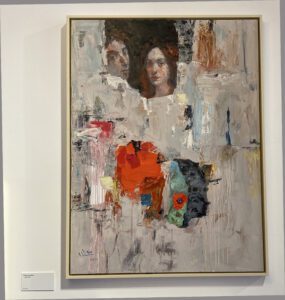Elizabeth Ashe

Exhibition photo – Liz Ashe
From Palestine: Our Past, Our Future fills a central gallery at Palazzo Mora, during the Venice Architectura Biennale. The exhibition focuses on two times, 1948-1955, and jumps to the contemporary. The older past of Turks and Bedouins are ignored, instead set on current living memory.
The Founder and Director of Palestine Museum US, Faisal Saleh, acted as first-time curator to produce the exhibition. In accounting for the core of his curatorial direction, he says for him, the focus behind the exhibition are the two maps, the animated one on a monitor with a time lapse of deaths and villages, and the map on the ground.
Music played overhead is tribal, but I don’t know if the songs are traditional (likely) or contemporary (clinging to traditional with some modern changes). A map of Palestine, 1948, dominates the first half of the floor, raised off the ground as a sloped plinth. The map is the first of three monumental scale pieces. On the left wall, is a pastoral painting by Nabil Anani, titled In Pursuit of Utopia. The rolling hills and farm plots feels very European, even Italian, with scattered Cyprus trees. The next is John Halaka’s “Stripped of their Identity and Driven from Their
Land,” of his series Forgotten Survivors, a monochromatic painting with dark figures on a grey-white background, hatched like cuneiform lines or dried chaff. The figures carry nothing, except sometimes each other, and they’re built-up and painted using ‘survivors’ and ‘forgotten’ stamps used like a contouring line. They could be survivors of anywhere, of any mass migration.
The best painting in the exhibit is Jidar, by Ghassan Abu Laban. It gives the viewer a named place, Jidar. A couple stands together in a cool, dark room, looking out from an uneven window. The wall is a gorgeous combination of abstraction and layers of facade. The painting makes me feel the dry air, the worn paint, their emotional closeness. Abu Laban’s work could carry the recent past of one generation, as a theme.
The abstract works could have been done by any abstract painter. Steve Sabella’s The Great March of Return is a photo montage of figures, bombs, and stars on a rotating circle. It looks like it belongs more as a videogame, as it moves too quickly and there is too much photo manipulation for me. Siege by Samira Badran, is a print on fabric. It is clear that Badran is a talented print maker, and I want to see more of her work. I’m intrigued by the narrative that could surface, the juxtaposition of a more defined army figure with trash and rubble. There could be valor and context, if there were more pieces that explain the rebar and trash coming out of the waistline/oil drum of a figure, the lower half of the body as army boots. Whose army does the figure belong to, and how old are they?
A museum-style display of monitors show students’ work, award winners of the 2022 Palestine Land Society. The four village projects are architecture dreams, from the generation who were born into violence-torn cities and deserve the chance to make peace with the place and build a utopia. As designs situated on a blank slate, on past-village sites, I appreciate how the work looks to design the future. They are excellent projects, and I want to see more, I want to see them realized. Displayed on monitors, I miss seeing the village infrastructure, and the connection to the land and history. I would like to see them solving history for the future, and I would like to see them considered as a viable next step away from generational refugee camps.
Overall, there are a few excellent pieces in the exhibit. I would like to have seen more work by a few artists, and much more about the students’ projects. There are several beautiful photographs — historical ones in black and white, and contemporary ones in color, but they are lost beneath the row of monitors. Margaret Olin’s photograph of a mural painted in a refugee camp is a particularly poignant look at the contemporary architecture in peoples’ lives, and I wish it was printed out large and on the wall. With more from fewer artists, I could connect with the work and learn how artists are treating architecture as a destroyed, or abandoned and reclaimed state where memory and cultures overlap, to envision the future and remember the past.
